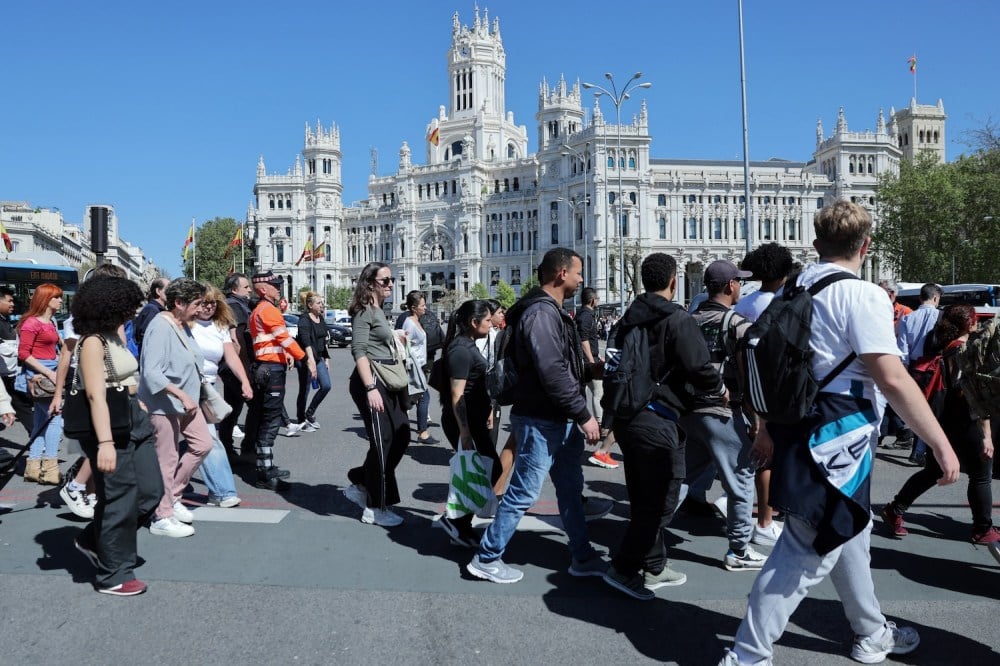The massive blackout that left Spain and Portugal in the dark on Monday brought home for many Europeans the overwhelming reliance their societies have on electricity—and the stability of the power system that provides it.
Western Europeans used to reliable trains and refrigeration were aghast at having to look for candles, but for much of the world, energy poverty (and brownouts and blackouts and rolling blackouts) is a frequent occurrence.
But the unprecedented blackout is helping shape an emerging new understanding in Europe of what energy security is and how it can best be addressed, after the continent spent decades worried more about dependence on fuel imports such as Middle Eastern oil or Russian natural gas. The need to ensure that climate-friendly policies, such as increasing use of renewable energy, go hand in hand with reliable electricity systems is shooting to the top of policymakers’ to-do lists.
Just days before nearly 50 million people were plunged into chaos due to a still-unexplained Iberian Peninsula-wide power outage, the International Energy Agency—itself a byproduct of energy availability fears stemming from the 1973 OPEC oil embargo—underscored the need for a new understanding of energy security that emphasizes a “holistic approach” including a more resilient power grid.
What were a week ago just technical talking points became this week an urgent reality.
“One has to ask: What were policymakers thinking over the past decade? The focus was on decarbonization and headline targets, but what about the basic foundations, like grid stability and resilience?” asked Lukasz Olejnik, a researcher and visiting fellow at the War Studies Department at King’s College London. “Those weren’t addressed with the same urgency. It’s always a balance and a trade-off.”
It’s still not entirely clear what caused the entire power systems of Spain and Portugal to go dark in a matter of seconds just after midday on Monday, knocking out not just the lights but also all mobile and most landline telecommunications. Initial fears of a cyberattack seem to have been ruled out. Though experts say such an attack might just be technically feasible, it would require a huge investment in money and resources—although other widespread blackouts, such as one affecting India in 2020 or Ukraine in 2015, were caused by malicious actors.
The latest theory is that the failure in Spain and Portugal stemmed from an over-reliance on renewable energy, especially solar panels, which deliver electricity to the power grid in a different way than traditional forms of power generation, such as nuclear or natural gas plants. Essentially, the evolving explanation is that the power grid did not have enough slack—inertia, in technical terms—to handle a sudden change in the output apparently caused by a drop in solar generation in southwestern Spain.
This is an issue that has vexed researchers for years as renewable energies such as wind and solar power have come to play a bigger role in electricity generation. The challenge posed by adding large amounts of renewable energy to the power grid is not just that the wind doesn’t always blow nor the sun always shine, but also that those sources deliver energy differently than do traditional forms of power generation. That can make power grids unstable at times of stress. When Monday’s blackout came, Spain’s grid was overwhelmingly powered by solar power, with only moderate amounts of nuclear energy, wind power, hydroelectric plants, and gas-fired turbines making up the balance.
There are a couple of previous big blackouts and studies of power grid resilience that are especially relevant for Spain’s case. In Texas, which like Spain has an isolated electricity system, essentially cut off from neighboring regions, researchers for years worked to understand how stable the grid would be as more renewable energy was added to the system. Texas had a massive power failure in 2021 during an extreme winter storm when the grid’s electricity sources struggled to perform in the frigid temperatures. In south Australia, a similar event occurred in 2016 as renewable sources of power overwhelmed a power grid built to operate according to old physics and older-generation technologies.
“In terms of renewable energy, the energy transformation needs to happen, but we need to acknowledge that there are new challenges for grid operators,” said Georg Zachmann, an energy expert at Bruegel, a think tank in Brussels.
What this week’s blackout brings in sharp relief is the need to reassess what energy security really means. For residents of Spain and Portugal, the loss of power, communications, transport, water supplies in some cities, access to cash machines, and even the ability to buy food in the space of minutes was jarring. Several Spanish regions asked the central government to mobilize the army to ensure order and deter looters as darkness fell. In a matter of hours, the country went from a spring afternoon to a nearly Mad Max scenario.
“Ultimately, people need a reliable source of energy. Building a modern civilization on unstable infrastructure is impossible,” Olejnik said.
For years, even though energy policy is mostly determined at the national level, the European Union has sought to balance its own vision of energy security, an energy transition to low-carbon sources of energy, and more affordable energy for consumers. That has always been a trilemma, with some goals (such as weaning off cheap Russian gas in favor of pricier imports from elsewhere) ticking one box while aggravating others.
But the accelerated drive toward a low-carbon energy system—Spain just over a week before the blackout celebrated a day when 100 percent of the country was powered by renewable energy—has recast the debate about what it means to be energy secure.
“Europe’s energy security problem in the past has been oil and gas, and now we want to move to a world where the imports are solar panels and we have electrified systems, which means much less import dependence but which brings with it a couple of other challenges,” Zachmann said. “Essentially all our electricity depends on this, the largest machine in the world, and we need to design it to have enough redundancy and ability to recover.”
In years past, when renewable sources of energy such as wind and solar power made up a smaller portion of the electricity mix, and legacy generators were still around and operating, grid stability was easier to achieve. But as policy decisions in some countries (such as Germany’s nuclear phaseout) or simple economics drive existing, reliable-but-dirtier baseload power generation out of the mix, the whole system threatens to become much more volatile.
There are a couple of solutions on the horizon: one technical, and one political.
The technical fix is to make changes to the power grid to make it better able to handle the new types of power generation that are required if Europe is to meet its goals of lowering carbon emissions and complying with climate change objectives. Those technical fixes can include changing the physical way that power generators interact with the grid to make a 20th-century analog system more akin to a 21st-century digital system.
Another approach is to backstop the power grid by adding stability the old-fashioned way, literally, by installing massive flywheels and fancy devices that spin the way that traditional turbines do, which helps integrate huge amounts of volatile new power generation.
Another option, and one that increasingly comes up in conversations about Spain’s blackout, is furthering the integration of Europe’s electricity network. Part of the problem this week was that Spain and Portugal are almost entirely isolated from the rest of Europe, electricity-wise: There are only a handful of interconnectors with France that allow cross-border flows of electrons north during the day, when Spanish solar is plentiful and cheap, and French nuclear power south at night.
But that greater interconnection has been a dream pursued in vain for years. As Zachmann noted in a paper, there are political and economic questions that stymie progress, including the thorny question of who pays and who benefits when cheap power flows to neighbors, raising prices locally.
But the bigger question right now, as was the case with financial integration in years past, is whether tighter bonds create more resilience and add shock absorbers to a complex system, or whether that just creates a bigger pool of risk if something goes wrong. Had Spain been better integrated with Europe’s power grid, it is unclear whether the result would have been to keep the lights on or to spread the blackout continentwide.
“Is it better to have more connections, or is it better to avoid the risk of contagion?” Zachmann asked.
The post Spain’s Blackout Brings a New Meaning to Energy Security appeared first on Foreign Policy.




